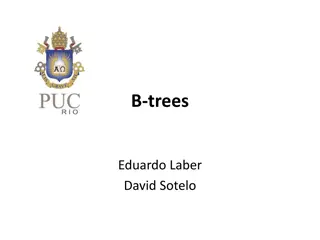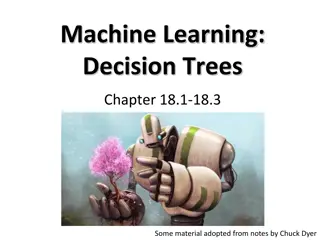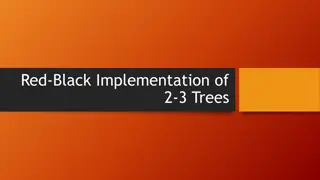Understanding Decision Trees in Problem Solving
A decision tree is a crucial tool in problem-solving, providing a systematic way to analyze and make decisions based on inputs. This content explores decision tree concepts, their application in sorting and binary search problems, and practical examples like the nuts-and-bolts matching dilemma. It delves into how decision trees reflect lower bounds of problem complexity, utilizing binary and k-ary structures to navigate through various scenarios efficiently.
Uploaded on Sep 11, 2024 | 2 Views
Download Presentation

Please find below an Image/Link to download the presentation.
The content on the website is provided AS IS for your information and personal use only. It may not be sold, licensed, or shared on other websites without obtaining consent from the author. Download presentation by click this link. If you encounter any issues during the download, it is possible that the publisher has removed the file from their server.
E N D
Presentation Transcript
Decision Tree Wu YuQing
Definition A decision tree is A tree Internal node query Leaf a label of output
The lower bound of a problem N different answers At least N different leaves the depth of the decision tree logkN the complexity of the problem (log N)
Information Theory The answers to the queries must give you enough information to specify any possible outputs. If a problem has N different outputs, then obviously any decision tree must have at least N leaves. If every query has at most k possible answers, then the depth of the decision tree must be at least logk N = (logN).
Problem Solving Dictionary Problem Let A be an array with n numbers. sorted Suppose we want to determine, given a number x, the position of x in the array A, if any.
Binary Search & Decision Tree Sort A Use Binary Search Be used directly as a Decision Tree
Sorting Problem n! possible permutations At least n! leaves depth (log(n!)) This gives us the lower bound
K-ary decision tree The examples describe binary decision trees Is x greater than, equal to, or less than y? A k-ary decision tree is one where every query has (at most) k different answers
nuts-and-bolts problem We are given n bolts and n nuts of different sizes, where each bolt exactly matches one nut. Our goal is to find the matching nut for each bolt. The nuts and bolts are too similar to compare directly; however, we can test whether any nut is too big, too small, or the same size as any bolt.
nuts-and-bolts problem 3-ary decision tree All the possible outputs : n! Suppose there are L leaves L<=3h
nuts-and-bolts problem in the worst case, (n log n) nut-bolt tests are required to correctly match up the nuts and bolts. in the worst case, (n log n) nut-bolt tests are required even to find n/2 arbitrary matching nut-bolt pairs
K-sorted Problem We say that an array A[1 .. n] is k-sorted if it can be divided into k blocks, each of size n/k, such that the elements in each block are larger than the elements in earlier blocks, and smaller than elements in later blocks. The elements within each block need not be sorted.
The lower bound of K-sorted Problem Make a decision tree model Suppose the height of decision tree is h All the possible output Suppose there are L leaves
The lower bound of K-sorted Problem requires (n log k) comparisons in the worst case K-sorted Problem has a lower bound (nlog k)
An algorithm for K-sorted Problem BFPTR algorithm Find the median in linear time Use the median as a pivot
K-sorted Problem sort a k-sorted array All the possible output requires (n log(n/k)) comparisons in the worst case
Application in data mining Supervised learning (with labels) ID3 C4.5 Introduction to Data Mining
Application in data mining Import numpy Random Forest
Reference ( ranked by contribution ) Lecture-note by jeffe Hengxin Wei Data mining : An Introduction CSDN Mr Yan























